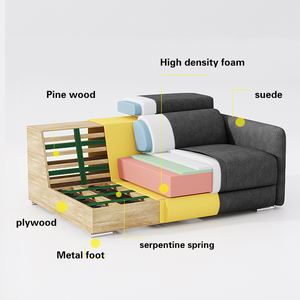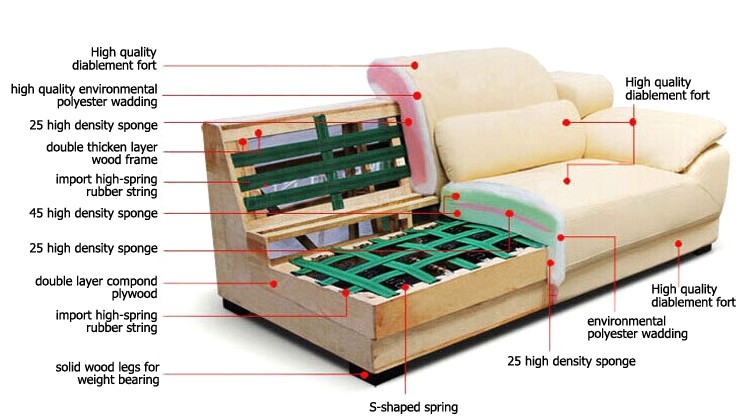Title: The Art of Sofa Reupholstering: A Comprehensive Guide
Sofa reupholstering is an art that requires patience and attention to detail. It involves removing the old fabric and replacing it with a new one, while maintaining the original structure of the sofa. This guide will provide you with everything you need to know about sofa reupholstering, from choosing the right fabric to attaching the new covering. We'll cover topics such as measuring your sofa, selecting fabric patterns and textures, and learning how to sew. With our comprehensive guide, you'll be able to transform your old sofa into a stylish and comfortable piece of furniture that matches your decor perfectly. Whether you're a seasoned DIYer or a beginner, this guide has something for everyone. So why not dive in and start your sofa reupholstering project today?
Introduction
The art of reupholstering a sofa is not just about covering old fabric with new. It's an intricate process that involves careful selection, measuring, cutting, sewing, and finishing to create a beautiful and functional piece of furniture that will enhance the overall look and feel of your home. In this comprehensive guide, we will walk you through the steps of sofa reupholstering, from selecting the right materials to attaching the new fabric to the old frame. By the end of this article, you will have the knowledge and skills needed to transform your old sofa into a stylish and comfortable centerpiece in your living room.
Step 1: Preparing the Sofa for Reupholstery
Before you start reupholstering your sofa, there are several steps you need to take to ensure a smooth and successful project. These include:

1、Clean the sofa thoroughly: Remove any loose threads, stains, or debris from the old fabric using a vacuum cleaner or a soft-bristled brush. Rinse the sofa with a mixture of water and mild detergent to remove any remaining stains or dirt. Allow the sofa to dry completely before continuing with the next step.
2、Assess the condition of the frame: Check the frame of your sofa for any cracks, dents, or broken components. If you find any issues, you may need to repair or replace them before reupholstering can begin. You can consult with a professional upholsterer or use online tutorials to learn how to do these repairs yourself.
3、Measure the sofa: Use a tape measure to determine the width and length of your sofa, as well as its depth. Make sure you also measure the height of the legs and any other decorative elements that may be attached to the frame. These measurements will help you select the appropriate size and shape of fabric for your new upholstery project.
4、Select the fabric: There are many factors to consider when choosing fabric for your sofa, including style, color, durability, and comfort. Consider your personal taste and the overall theme of your home when making your selection. You can visit a local fabric store or browse online retailers for inspiration. Some popular options for sofa upholstery include leather, fabric, microfiber, and velvet.
5、Purchase any necessary supplies: In addition to fabric, you will need several tools and materials for reupholstering your sofa, including thread, needles, scissors, seam ripper, iron, and clamps. Make sure you have all of these items before beginning your project.
Step 2: Removing the Old Fabric
Once you have prepared your sofa and selected your fabric, it's time to remove the old upholstery. Here's what you need to do:
1、Loosen any screws or bolts that hold the cushions in place: Using a screwdriver or Allen wrench, loosen any screws or bolts that are holding the cushions in place. Carefully remove each cushion one at a time until they are free from their attachments.
2、Slide out the frame: Gently slide out the frame from underneath the cushions. Be careful not to damage any of the wood or metal components along the way.
3、Remove any remaining padding or foam: If your sofa has any padding or foam underlayment, carefully lift it away from the frame using a tool like pliers or your fingers. Be careful not to tear or damage the foam material.
4、Disassemble any remaining hardware: If your sofa has any additional hardware, such as arms or leg extensions, carefully disconnect them from the frame and remove them from the sofa.

Step 3: Cutting and Sewing the Fabric
With all of the old upholstery removed, you are now ready to start attaching new fabric to your sofa frame. Here's what you need to do:
1、Lay out your new fabric on a flat surface: Arrange your new fabric so that it matches the pattern and color of your old upholstery as closely as possible. Make sure you have enough fabric to cover both sides of the frame and extend past any edges where the fabric may be exposed once it is attached.
2、Cut the fabric pieces: Using sharp scissors, cut two pieces of fabric that are slightly larger than the width of your frame at its widest point. Cut two more pieces that are slightly larger than the length of your frame at its longest point. Cut two more pieces that are slightly larger than the height of your legs (if applicable).
3、Apply glue or adhesive: Depending on the type of fabric you are using, you may need to apply a glue or adhesive to one side of each piece of fabric before attaching them to the frame. This will help prevent the fabric from shifting or wrinkling as you work.
4、Attaching the Fabric to the Frame: Begin by attaching one long piece of fabric to the bottom edge of your frame using staples or stitches. Then attach another piece of fabric along the back edge of your frame, perpendicular to the first piece. Repeat this process until all three sides of your frame are covered with fabric. Finally, attach any remaining pieces of fabric along the top edge of your frame if necessary.
5、Sewing Seams: Once all four sides of your frame are covered with fabric, sew any open seams together using a strong needle and thread that is suitable for your chosen fabric type. Make sure to reinforce any stress points where the fabric may be particularly prone to tearing or fraying.
6、Finishing Touches: Once you have completed all of your sewing tasks, it's time to focus on adding some finishing touches to your new sofa upholstery project. This might involve trimming excess fabric around any edges or corners where it may be visible, applying a protective coating to prevent staining or fading, or adding decorative elements such as pillows or cushions in complementary colors or styles.
Conclusion
Reupholstering a sofa is no easy feat, but with patience, attention to detail, and a little creativity, anyone can transform an old couch into a stylish and comfortable centerpiece in their home. By following these steps carefully and taking your time throughout each stage of the process, you can create a beautiful new look for your furniture that will be enjoyed for years to come. So why not give it a try? Your friends and family will thank you!
Articles related to the knowledge points of this article:
The popularity of down jackets
The rise of the mens down vest
Title: What to Do When Your Tie Frays in the Middle of a Meeting?
Title: The Alluring Beauty of the Gucci Little Bee Tie - A Fashionable Accessory for the Modern Man
The Majestic allure of the Great Scarf: An Exploration of its Cultural Significance and Versatility
Title: The Art of Elegance: Exploring the Timeless Beauty of Silk Scarves and Handbags



